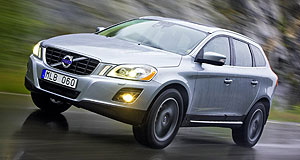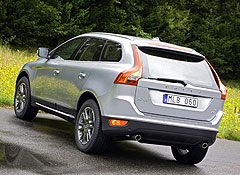Sharp pricing for XC60
BY DAVID HASSALL | 5th Jan 2009

At $57,950 for the entry-level XC60 D5 2.4-litre turbodiesel model, the new SUV – which officially reaches Volvo showrooms from March – undercuts the equivalent 2.0-litre TDi BMW X3 by almost $4000.
A more highly-equipped XC60 ‘LE’ turbodiesel model is priced at $64,450, but the company has not yet revealed its specification list.
Volvo’s petrol-engined variant, the XC60 T6 powered by a 3.0-litre turbo six, enjoys a near $10,000 price advantage over the BMW xDrive30i Lifestyle model, with a sticker of $64,950 versus $74,877.

Volvo Car Australia managing director Alan Desselss said the new XC60 has been “priced to issue a real challenge in the prestige SUV segment” and will be well-equipped.
As previously reported, the XC60 will be fitted standard with the newly-developed ‘City Safety’ low-speed automatic braking system, which is designed to prevent – or at least minimise – collisions at speeds below 30km/h, which the company says accounts for some 75 per cent of all reported accidents.
Furthermore, Volvo says that surveys indicate that in 50 per cent of those cases – which means more than one-third of all accidents – the driver has not braked at all before the collision, mainly due to having been distracted.
Volvo’s new low-speed system – as opposed to its own and other car-makers’ systems that operate at higher speeds – should reduce the number and severity of these relatively slow but nevertheless annoying and expensive accidents.
It employs a laser sensor located at the top of the windscreen to monitor closing speeds within 10 metres of the vehicle’s front bumper, then preparing and sometimes activating the brakes before the driver has reacted to an impending collision.
Based on the gap to the vehicle in front and the XC60’s speed, Volvo’s City Safety system makes 50 calculations a second to determine what braking force would be needed to avoid a collision.
In a low-speed situation such as stop-start traffic, if the vehicle in front brakes suddenly and the program determines that a collision is imminent, the brakes are ‘pre-charged’, making them ready for rapid application. Should the driver remain inactive, the car will apply the brakes automatically.
If the relative speed difference between the two vehicles is less than 15km/h then City Safety may help the driver entirely avoid the collision. Between 15 and 30km/h, the focus is on reducing speed as much as possible prior to the impact.
Volvo claims that the XC60 is now its safest ever vehicle.
“The new XC60 will further raise the levels of dynamism within the Volvo lineup, as well as introducing what is perhaps the greatest step forward yet in terms of active safety with the new City Safety system,” said Mr Desselss.
He said that the XC60 will redefine expectations of medium-size SUVs with new levels of handling and roadholding, as well as a large, cleverly-designed interior.
The two-engine line-up from launch includes the familiar five-cylinder turbodiesel, which produces 136kW of power and 400Nm of torque (versus 125kW/340Nm for the smaller capacity BMW) and has average fuel consumption of 8.3L/100km in six-speed Geartronic adaptive automatic form, and a 3.0-litre turbo petrol six-cylinder that produces 210kW and pushes the XC60 T6 from 0-100km/h in a BMW-matching 7.5 seconds.
Power and stability are handled by a Haldex electronically-managed all-wheel drive system, electronic stability control, a Roll Stability Control system and ABS brakes with Electronic Brake Distribution and Brake Assist.